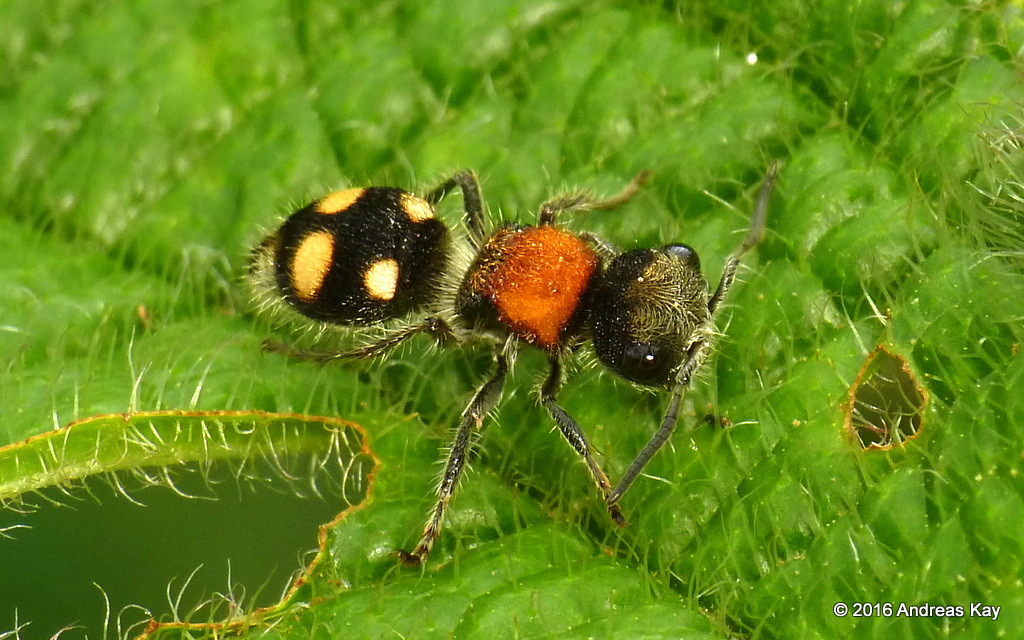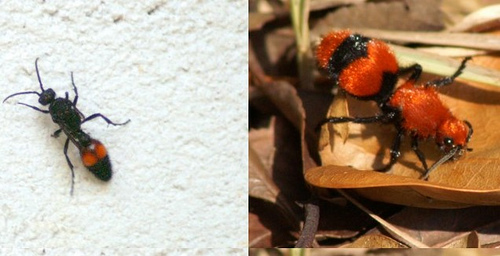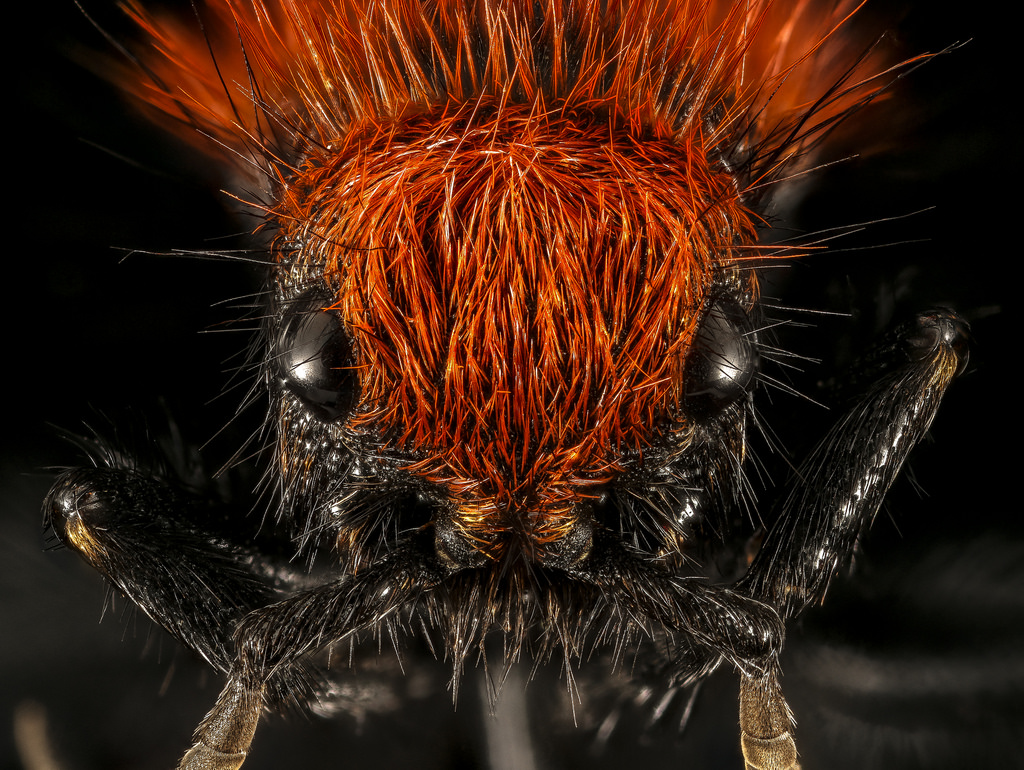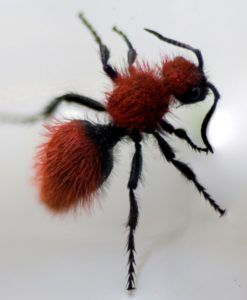Red Velvet Ants or Cow Killer Ants

It's Really a Wasp
Working outside, and in Education, I often get queries and questions about things people find in their yards or sidewalks. This week was no different, one of the researchers where I work messaged me asking about a big red fuzzy ant that has a black stripe on it. This fuzzy visitor is quite common in the Eastern US so it was an easy ID, but I thought it worth doing a post to introduce you to some quick facts about red velvet ants, also called cow killers, and their relatives. Most species of velvet ants are found in the southern and western parts of North America, and there are over 50 species in Florida alone,

Velvet Ants Aren't Ants (But They're Related)
Red velvet ants belong to the family Mutilidae (not reassuring when any family name includes "mutilate" in the name), order Hymenoptera, which is a group of about 435 species of wasps. Yes, they look like ants, because they are closely related. The order Hymenoptera includes bees, ants, and wasps. Regardless, the name has stuck so I'm going to call them red velvet ants for the purposes of this article (replace ant with wasp in your best scientists voice inside your head when you see it). The most common one around our area (Eastern US) is the species called Dasymutilla occidentalis occidentalis (pictured below).

Female Velvet Ants Are Flightless and Look Different Than Males
Scientists like big terms for everything, so to say that males and females are different it's called "sexual dimorphism" (males look different than females). In many cases they have the even fancier distinction of "reverse sexual dimorphism" which sounds like a bunch kinky wasps, but it just means that males are bigger than females, and they look different from each other.
For a long time male and female velvet ants were not classified in the correct groups because they look so different. Females are brightly colored and wingless (not all are red, some are orange or even black and white), and they hunt around on the ground while males can be a completely different color, they fly, and are found higher up in vegetation. Matching the two required some pretty serious observations of ant-philes and researchers to figure out what was going on.
Females tend to be brighter because unlike males they can't fly away from predators. In many bird species it's the other way around, males are brighter and the females are more drab, but in velvet ants flightless females send out strong warning signals with their color.

Red Velvet Ants Have Many Ways to Protect Themselves
STINGS
You know that if something is nicknamed the "cow killer" it's not because it's cute and cuddly. The nickname comes from the female wasp's sting. Almost all red velvet ants deliver a crazy painful sting, and the old wives' tale goes that it is so painful that it could "kill a cow." They don't really kill cows, but they do pack a wallop.
Only the females sting, not the males, and the female velvet ant's stinger isn't a stinger like you think of for bees, its really a modified egg laying tube called an ovipositor (Oh-ve-poz-it-ter). Males can't sting but they will "fake it" and poke you painfully with their sharp genitalia. It still hurts enough for you to want to drop them. If anything stabs me like that I sure as heck am going to drop them.
A velvet ant's venom may hurt when you're stung (yes you're going to say impolite adult things) but the venom itself isn't really that toxic compared to other ants, like the harvester ant or even the honey bee (if you're outside a dob of mud on the wound sometimes can help neutralize the venom, but I'm not a doctor, it's just an old field remedy).

COLORATION
Velvet ants don't just use a powerful sting to defend themselves, most also have a combination of traits ranging from smelly chemical secretions, bright red or orange warning signs (never play with anything in nature that is bright red), sound signals, a super hard outer shell, and their bite. If you're looking for a good science-y read then you can read the paper by Wilson , Jahner, and Forister all about how North American velvet ants have one of the world's largest Mullreian mimicry complexes. Mullerian mimicry is when two or more species look like each other to warn off other animals from eating/attacking them. There are 336 species of velvet ant that look alike to warn off predators. That's a lot of species relying on their "don't screw with me or my cousins or I'll sting you" look to keep from being messed with. Regardless of their fierce looks and reputations, red velvet ants (and their cousins) don't want to sting. They're not aggressive and will avoid stinging as much as possible.

SQUEAKS
Let's repeat, velvet ants don't want to sting. Both males and females have abdomens (metasoma) made up of overlapping plates. On the plates is a structure called a stridulitrum (st-rid-you-light-rum). This consists of a well "scraper" or ridge of one of their butt plates being rubbed across another finely ridged butt plate surface called the "file." Making these squeaking sounds is called stridulation (st-rid-you-lay-shun). They make sounds by rubbing body parts together, much like grasshoppers (but for ants its their body sections and not wings or legs). Don't believe me? Turn up the sound and watch this video:
In the following video you can hear a red velvet ant squeak around 0:09 in the video:
Red Velvet Ants Zombie Masters
I'm surprised that horror movie makers haven't picked up on the story of velvet ants because the'd make for a great "B-flick" movie. All velvet ants are parasatoids. This means that their young develop in or on other insects. After flying around the males find a female and mate. The female then goes off alone to look for the underground sealed dens of other solitary wasps or ground nesting bees where their larvae are hidden. The female lays an egg near the larvae of their prey and then leaves after re-sealing it back in. The larvae of the velvet ant hatches and then starts chewing its way inside the body of the host, where it eats the host dry from the inside out, pupates, and then crawls out as a fully formed adults. Gruesome! However, the adults feed mostly on nectar and the larvae of other insects such as flies, beetles, wasps, and bees.

Regardless of what you think of their lifestyle, the velvet ant is truly made for its lifestyle. The red velvet ants that you see on your sidewalk, or around your home, are marvels of biological adaptation. Remember, they don't want to sting you (or poke you with their genitals), they want to be left alone, and they'll even tell you so with a squeek. So listen up, and let these ecologically important species go on their way. After all they are taking care of ground wasps and bees around your home.

